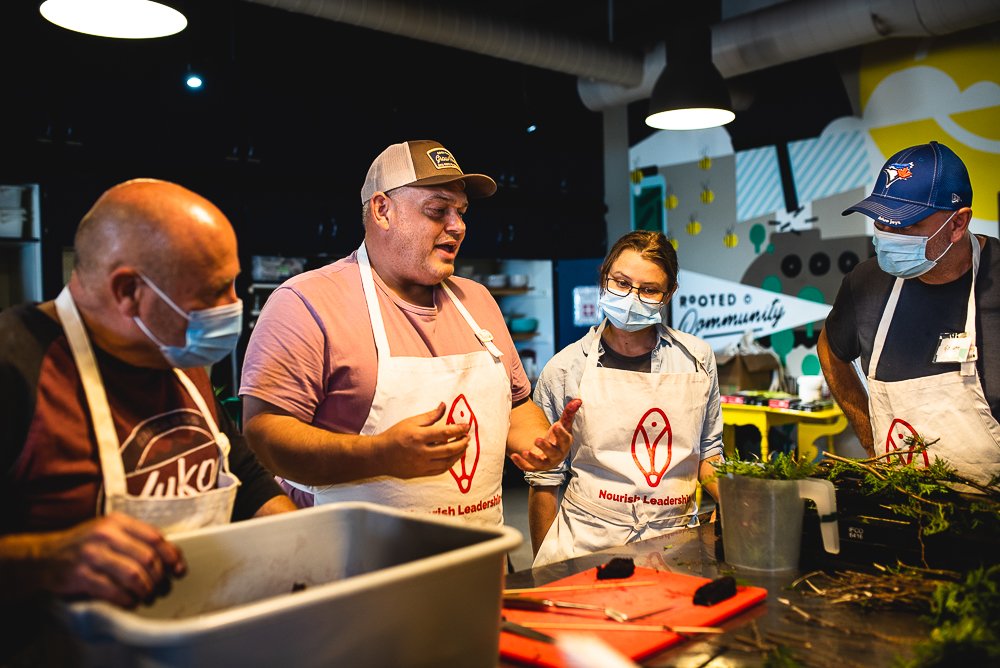By Allison Gacad, Loran Scholar and Nourish Researcher and Annie Marquez, Nourish Innovator
A meal at a healthcare system is a juggling act of numerous priorities: is it nutritionally adequate for the patient? Does it fit within the allocated budget? Are there a variety of colours and textures on the plate? Among these questions, a new priority is beginning to emerge: how sustainable is this meal?
“The most powerful path to being sustainable as a healthcare institution isn’t through turning off the lights or unplugging electronics – it’s in changing the way that patients eat.”
The most powerful path to being sustainable as a healthcare institution isn’t through turning off the lights or unplugging electronics – it’s in changing the way that patients eat. From the production of the ingredients to the processing at a factory, to the transportation required to bring the food to the plate, the creation of a meal radiates social, economic, and environmental effects well beyond the person who is eating it. When we amplify this by the thousands of meals prepared, served, and consumed daily in healthcare institutions across Canada, the impact is monumental.
The choices that food service managers make about what is served on the plate ultimately influence global systemic issues of climate change and public health. Despite this immense opportunity for proactive change, not all food service managers are equipped with the knowledge and tools to act in the interest of environmental sustainability.
Nourish Healthcare’s Sustainable Menus collaborative working group is a team of healthcare leaders looking to address this knowledge gap and transition food in healthcare towards sustainability. Through the creation of a practical and user-friendly sustainable menu guide for food service managers, the group is looking to mobilize sustainable food choices in healthcare and the reduction of greenhouse gas emissions. Below are some of the pathways towards sustainability presented in the guide:
Moving towards plant-based proteins
Agriculture — the system that powers the production of our food — accounts for nearly 24% of global greenhouse gas emissions. However, the production of certain types of foods are more resource intensive than others. Livestock — including red meats, pork, and poultry — contribute to 18% of global greenhouse gas emissions. Large volumes of water are needed for livestock to drink and maintain hygiene. Vast amounts of land are used to produce their feed and even their natural digestive processes directly contribute to the greenhouse gases in our atmosphere.
In contrast, plant-based proteins such as legumes benefit soil ecosystems rather than impair them. Legumes are recognized as “soil building crops” thanks to their properties which improve soil structure, reduce erosion, and increase organic content.
For most healthcare facilities, traditional protein is animal-based and is usually in the form of beef or pork. Transitioning into plant-based proteins can be challenging, but even small efforts can have massive impacts. According to Healthcare Without Harm, “Eliminating meat for one day per week, for example, could reduce emissions by an estimated 1.0 gigatons (Gt) to 1.3 Gt. per year, the equivalent to taking 273 million cars off the road.” Plant-based proteins are also substantially cheaper than their animal protein equivalents, in fact being approximately 4 times less expensive per gram of protein.
Less processing, more whole foods
Chicken nuggets, bags of chips, and microwavable meals: ultra-processed foods have little resemblance to whole foods. They are better described as formulations of industrial ingredients and other substances derived from foods and additives. Not only are these foods full of calories and have limited nutritional value, but the energy and water required for their production is extensive. Processed foods are also a source of ample plastic waste due to the packaging of the products to optimize transportability.
The convenience of ultra-processed foods is attractive in healthcare settings. Pre-packaged portions make it easy to serve clients – but at a cost to nutrition, sustainability, and sometimes even budgets. Instead, looking to whole foods or minimally processed foods such as raw fruits and vegetables or simple baked goods can be beneficial for patients and the planet.
Local food, local economies
Prioritizing the procurement of local foods is path that can help meet priorities around creating delicious, sustainable and cost-efficient meals.
In a recent article in Food Service and Nutrition Magazine, Jennifer Reynolds of Food Secure Canada describes the following 5 reasons for buying local food:
Reducing food miles: The smaller the distance food needs to travel, the smaller the environmental impact.
Fresher, more flavourful food: Local food is often harvested only hours before being sold – the freshness results in better taste.
Seasonal eating: When fruits and vegetables are in season, they are at peak flavour and ripeness.
Supporting local economies: Producers directly receive profits and consumers learn how their food is grown.
Transparency: Consumers gain a better awareness of what they’re buying.
Reducing waste
Food waste leads to lost calories, money, and energy. In 2010, the annual value of food wasted in Canadian hospitals was about $45 million. This was the result of either kitchen food waste, where food may be overproduced or prepared inefficiently, or patient food waste, where food is left uneaten and remains on the plate. Hospital kitchens can use simple methods of reducing waste such as freezing leftover bread or pureeing proteins into soup in order to maximize use of the ingredients purchased.
Reducing food waste is a sustainable action that also meets needs around enhancing patient health and satisfaction. Observing how much and what foods are left on the patient plate can empower care providers to identify signs of malnourishment and support food service managers in identifying recipes that need to be improved.
--
“Moving forward, it is vital that we see healthy food as synonymous with sustainable food, for the health of the patient, population and planet.”
There is no doubt that making sustainable food choices can nourish both patients and the wider environment. Health care facilities which elect to prioritize sustainability in their kitchens will emerge as leaders in public health. As climate change continues to aggravate existing global problems such as food security, infectious diseases and extreme weather patterns, making sustainable food choices is part of the public responsibility of hospitals to reduce the impact of a warming climate. Moving forward, it is vital that we see healthy food as synonymous with sustainable food, for the health of the patient, population and planet.









